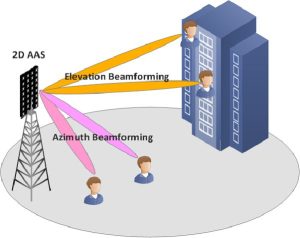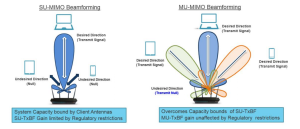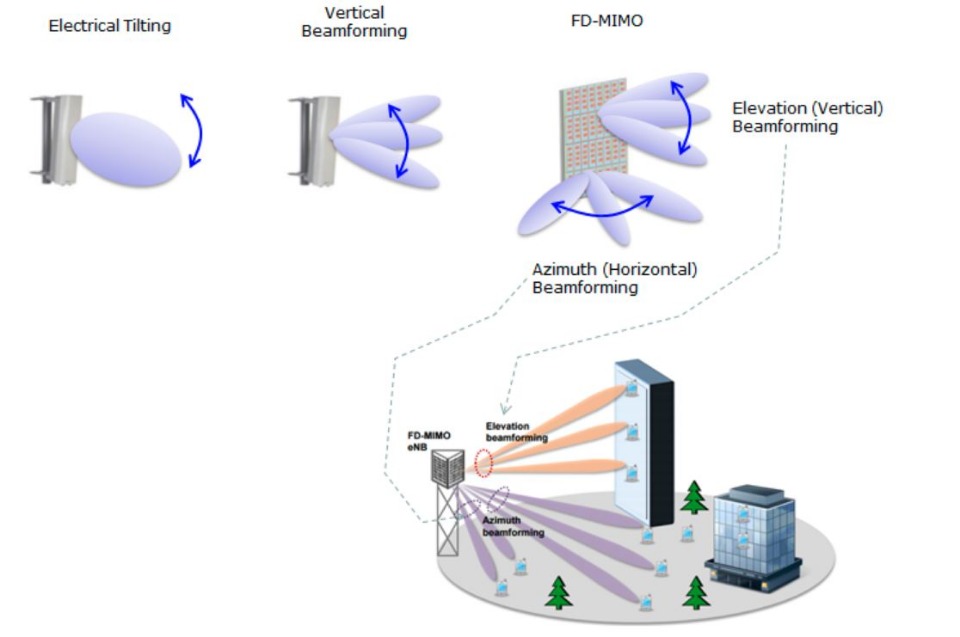Beamforming, a technique used in wireless communication systems to improve signal quality and data transmission rates, has been around for some time. However, with the emergence of 5G networks, it has gained significant attention. Beamforming techniques have become an integral part of massive MIMO systems that use multiple antennas at both ends.

Massive MIMO is a remarkable technology that employs numerous antennas to amplify data throughput and decrease interference levels. In this system, beamforming plays a critical role in directing signals towards specific users or devices while minimizing noise levels. One advantage of beamforming in massive MIMO is its ability to provide higher spectral efficiency by focusing energy on particular areas.
Transmit beamforming is another type of beamforming technique where signals transmit simultaneously from multiple antennas while adjusting their phase shifts to create constructive interference at the receiving end. This can be implemented using either analog or digital RF processing techniques depending on system requirements. Transmit beamforming offers several advantages over traditional antenna arrays as it enables higher spatial resolution without increasing complexity or cost.
In conclusion, understanding the fundamentals of beamforming in MIMO radio systems is vital for anyone interested in wireless communication technologies such as 5G networks and beyond. The combination of massive MIMO and beamforming techniques provides significant advantages over traditional approaches by improving spectral efficiency, reducing interference levels, increasing data throughput rates among others – researchers are continually exploring new ways to overcome challenges associated with implementing these advanced technologies into real-world applications!
Advantages and Disadvantages of Beamforming Techniques in Wireless Communication
Contents
- 1 Advantages and Disadvantages of Beamforming Techniques in Wireless Communication
- 2 Exploring the Application of Beamforming in Cellular Communications
- 3 Massive MIMO Systems and Beamforming Algorithms for Improved Performance
- 4 Transmit Beamforming and Hybrid Beamforming in MIMO Communication Systems
- 5 Analyzing the Limitations of Beamforming in Wireless Systems
- 6 Overcoming the Challenges of Beamforming in MIMO Radio Systems with Signal Processing Techniques
- 7 Future Directions for Beamforming Research in Networks and Beyond
Beamforming, a technique used in wireless communication that employs multiple antennas to direct signals towards specific receivers, has been hailed for its ability to enhance signal quality and reduce interference, especially in areas with high population densities like stadiums or urban centers. This makes it an indispensable tool for Wi-Fi beamforming where rapid data transfer is paramount.

However, despite the undeniable advantages of this technique, there are still some challenges to overcome. One major issue is the computational intensity required and significant processing power needed for effective implementation. Moreover, if not calibrated correctly digital beamforming may introduce delays or phase errors into transmitted signals.
Nevertheless, interest in applying beamforming techniques continues to grow as next-generation wireless networks such as 5G and massive MIMO systems rely on advanced antenna arrays and sophisticated algorithms designed to achieve higher data rates while improving spectral efficiency compared to traditional cellular networks.
Thus it’s clear that although drawbacks exist when using beamforming techniques in wireless communication; their potential benefits make them undeniably crucial research targets aimed at enhancing network performance and delivering faster yet more reliable connectivity across numerous applications.
Exploring the Application of Beamforming in Cellular Communications
The pervasiveness of cellular communications in our daily lives is undeniable. With the ever-increasing demand for high-speed wireless communication, novel solutions are required to address the challenges that arise. Enter beamforming techniques – these methods have been shown to significantly improve signal quality, reduce interference and increase capacity.
In both base stations and mobile devices, beamforming algorithms have proven their utility time and again. At a base station, analog or digital circuitry controls multiple antenna elements within an array to adjust each element’s phase and amplitude. The result? A focused transmission in a specific direction toward the receiver.
What truly sets beamforming apart is its ability to optimize performance while minimizing hardware complexity through hybrid beamforming. By focusing energy on a particular spatial region where it is needed most whilst suppressing interference from other directions, better frequency reuse can be achieved along with improved spectral efficiency resulting in higher data rates for end-users.
Massive MIMO systems also further enhance this technology’s capabilities by using advanced signal processing techniques like precoding which improves transmission performance even more through spatial multiplexing.
Overall, it’s clear that beamforming has revolutionized the world of wireless communication as we know it!
Massive MIMO Systems and Beamforming Algorithms for Improved Performance
The popularity of massive MIMO systems and beamforming algorithms is skyrocketing in the field of wireless communication. It’s perplexing how these techniques have the ability to enhance signal quality, data rate, and overall performance. Analog and digital processing techniques are used for beamforming to direct a transmitter’s signal towards a particular user or direction by adjusting the amplitude and phase of transmitted signals at each antenna element resulting in constructive interference.
Massive MIMO systems possess an incredible advantage as they can employ spatial multiplexing which allows different antennas to serve multiple users simultaneously that could increase RF channel capacity while maintaining high signal quality. Interference mitigation is another added bonus with beamforming where nulls can be steered towards interfering sources.
With increasing demands for higher data rates and better coverage, 5G networks will depend heavily on massive MIMO systems. However, it bursts with challenges such as hardware complexity and power consumption that need immediate attention. Research is ongoing to develop more efficient algorithms considering factors like wavelength spacing between antennas and baseband processing requirements. One thing we know for sure – advancements in digital signal processing technology will continue providing surprising improvements in wireless communication performance through massive MIMO systems over the years!
Transmit Beamforming and Hybrid Beamforming in MIMO Communication Systems
The world of 5G wireless systems is a complex one, filled with cutting-edge techniques designed to maximize performance and coverage. Two such techniques are transmit beamforming and hybrid beamforming, each with its own unique strengths and weaknesses.
Transmit beamforming relies on the power of multiple antennas working in concert to send a signal that’s stronger than any one antenna could produce on its own. By varying the phase and amplitude of each signal, this technique can improve overall system performance in ways that were once thought impossible. However, there’s a catch: you need an awful lot of antennas to make it work.
Hybrid beamforming takes a different approach altogether by combining analog and digital processing methods into a single streamlined package. This allows for better control over hardware complexity without sacrificing overall system efficiency or coverage. With only a few RF chains connecting many antennas through an analog network, the remaining processing can be handled digitally using advanced digital processing units (DPUs).
Of course, there are many types of beamforming techniques out there – from maximum ratio transmission/combining (MRT/MRC) to zero-forcing (ZF) or minimum mean square error (MMSE). Each has its advantages and disadvantages depending on specific use cases or scenarios encountered in real-world applications. Signal processing plays an important role in boosting these methods’ effectiveness while reducing interference from neighboring cells or users within the same cell; however, challenges like fading channels or noise levels remain serious obstacles that must be overcome if we hope to realize the full potential of these powerful technologies!
Analyzing the Limitations of Beamforming in Wireless Systems
The perplexing nature of beamforming in wireless systems lies in its requirement for a multitude of antennas. The use of multiple antennas enables directional transmission, which is undoubtedly advantageous as it enhances energy efficiency and reduces interference. However, the flip side to this coin is that more hardware is necessary for implementing beamforming, leading to escalated costs and complexity.
Another source of bewilderment when it comes to beamforming is the indispensability of precise phase shifters required to steer the transmitted signal towards the intended destination. This entails meticulous calibration and alignment of antenna elements – an endeavor that can prove arduous in practice. Furthermore, even slight errors or deviations in phase shifting could result in compromised performance or complete failure of coordinated beamforming.
Despite these puzzling limitations, there are still numerous potential applications for beamforming with cellular networks utilizing massive MIMO technology. One benefit associated with using massive MIMO alongside digital domain beamforming is improved spectral efficiency and heightened capacity compared to traditional techniques employed for beamforming purposes. Additionally, ongoing research aims at surmounting these challenges by applying advanced signal processing methods such as compressive sensing and machine learning algorithms specifically tailored at enhancing the performance capabilities of beamforming systems – particularly those used with Wi-Fi 6e/7/8and 5G technologies.
Overcoming the Challenges of Beamforming in MIMO Radio Systems with Signal Processing Techniques
The perplexing task of beamforming lies in the ability to precisely direct signal transmission towards a designated receiving device. This enigmatic feat requires sophisticated digital signal processing techniques that can accurately locate and orientate the device while optimizing data transmission frequency bands.
To surmount these challenges, researchers are delving into newfangled concepts of beamforming that grant even more precise control over signal directionality and quality. One such technique is hybrid beamforming, which allows for multiple beams to be emitted simultaneously, targeting distinct users or groups within a network with ease.
Furthermore, scalability remains an important consideration when implementing 5G systems and other cellular communications networks. As the number of devices on the network increases along with demand for higher data rates, traditional approaches struggle to maintain optimal performance levels.
By harnessing advancements in digital signal processing technology and creating novel algorithms specifically designed for beamforming applications, researchers aspire to conquer these obstacles and unleash even greater potential for this formidable technique within future wireless communication systems.
Future Directions for Beamforming Research in Networks and Beyond
As we witness the relentless evolution of communication technology, one question continues to baffle even the most seasoned experts: how can we transmit data more efficiently and effectively? Enter beamforming – a revolutionary antenna technology that directs radio waves towards specific directions instead of allowing them to scatter indiscriminately. The result? Wireless communication systems with unparalleled capacity and network performance.
But there’s more. Beamforming has shown immense promise in the development of Wi-Fi networks, particularly in broadcast antennas. Digital precoding techniques allow signals to be steered towards specific devices or areas, resulting in improved range and throughput. However, challenges remain: limitations on range and interference from other sources continue to plague this technology.
Enter researchers who are exploring new approaches by combining multiple beamforming techniques with advanced signal processing algorithms – these hybrid systems could potentially offer even greater improvements while overcoming some traditional beamforming methods’ inherent limitations.
So what’s next? Future research will likely focus on developing sophisticated antenna arrays capable of supporting massive MIMO (Multiple Input Multiple Output) systems with hundreds or thousands of individual elements; advances in machine learning and artificial intelligence may enable even more precise control over transmitted signals’ directionality and strength. And as perplexing as it all may seem, the possibilities for faster speeds and higher reliability across a wide range of applications have never been greater!


